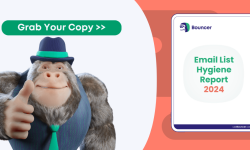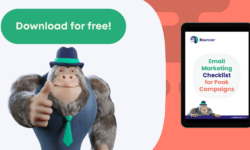Email marketing is a solid strategy that most businesses use in modern times. They are an excellent way to connect to the masses, get your message across, offer promotions, and boost engagement with your platform.
However, just like anything, these emails can sometimes drift away from the intended recipient and be left unread in their inbox week after week. When this happens, it is time to introduce a reliable re-engagement email to see if you can re-spark the interest that inspired the subscription in the first place.
Today, we’re going to show you what re-engagement campaigns are and how you can use them for your email marketing efforts.
What is a re-engagement Email?
A re-engagement email primarily focuses on bringing a user back to the subscription platform with enticing or emotive strategies. When a person initially signs up for email marketing, there is usually a reason behind it.
For example, a voucher was offered as a reward or to access members’ content. When this has long been forgotten about, the emails that follow may be left unread and sit desolate in an inbox. The target, therefore, is to draw the customers back in and re-engage them.
Re-engagement emails (sometimes called a win-back email) are campaigns that aim to get back inactive subscribers or remind them why they subscribed in the first place.
The advantages of re-engagement email campaigns for companies
Why do companies need this format? Multiple advantages can be gained from sending out these types of emails to users and customers, even if the customer has never completed a purchase. Read on below to find out more.
Remind inactive subscribers why they joined you in the first place
If someone has failed to open the last ten or more subscription emails, regardless of the format (newsletter, promotion, etc.), they are at a higher risk of unsubscribing entirely. A well-worded, client-focused re-engagement piece may turn the tide and spark some long-lost joy.
Make active and inactive customers feel valued
Finding the balance between personalizing the customer experience and appealing to the masses is hard. While re-engagement emails may be sent out to multiple people and have pretty much the same content word for word, they still act as a validation tool. Why?
Because the company has noticed that you’re not paying them attention, they want you to try again. The act of reaching out is, in itself, an empathetic move that inevitably creates a connection. This connection might, at the very least, persuade a customer to stay a bit longer and possibly even lead to a sale.
Increased potential for sales from existing email lists
The main goal of re-engagement emails is to produce a sales lead. Enticing customers back into the fold when they have been ignoring emails is an unpredictable task. The results are never consistent, and the outcome depends on multiple factors.
However, when a customer does accept the intentions of the re-engagement narrative and consequently re-engages, there is an increased chance that a sale is on the way.
Send out new promo offers to active and inactive subscribers
If the company is only running a promotional offer to new customers, it is an excellent opportunity to extend to the ones you are trying to reconnect with. Offering a promotion or highlighting a currently running one is a good way to get customers excited again.
Add to your existing marketing mix
Marketing has to consider every single customer profile, even the ones that have never bought anything. Analyzing the data helps define customers into categories and highlight what works and doesn’t. Re-engagement tactics are just one part of this.
The potential disadvantages
Of course, there are always potential disadvantages to be taken into consideration.
Even effective re-engagement emails can be seen as spam
The emails may never find their home. The customer may mark it as spam if they haven’t already, which means not only will the effect be lost bu,t the marketing strategy will also be redundant, wasting time and money.
Potentially annoying to your email subscribers
There has to be a reason why the customer has not been looking at the correspondence from said business. Whether they have had the promotion and therefore see no further use, or there are too many being sent over a week, or the content is just a bit boring. All these reasons are valid to the customer; therefore, a significant gesture email may not have the desired effect and instead be seen as annoying or even leave them feeling harassed.
Could be the reason why people unsubscribe
Sadly, it could be the last straw that inspires the unsubscribe click! Every email marketer knows that recipients can unsubscribe or change their email preferences. A re-engagement campaign sent to your email lists may be the cause for inactive users to hit the unsub button.
Re-engagement email examples
The discount email
‘ Dear Thea, we noticed you haven’t shopped with us in a while. Here is 15% off to help you find a great deal!’.
The theory is simple here. Offer the client a discount to bring them to your site or into the store. People are more likely to engage with a sale if there is a voucher to make it feel like a good bargain. Make it too good to miss but be realistic with what you can offer.
The “we miss you” email
‘Hi John, we miss you! You haven’t been around in a while; where have you got to? There have been some great new products you’re missing out on!’
This is supposed to create an emotional connection and give the impression that you’re thinking about them and noticing their absence.
It helps businesses make the experience more personal and enables customers to feel appreciated. These types of reactivation emails may work on some inactive users, but if this is the single email they get in a year, don’t expect miracles.
Asking a leading question
‘ Hi Leah, did you know we have a new range in for the winter? There are lots of products waiting for you to browse.’
Asking a leading question is thought-provoking. It draws upon an organic cognitive process that is natural to all humans. It is a solid strategy to draw upon because when we’re asked a question, we want to provide an answer.
Highlighting changes in the recent period of time
‘Dear Max, there have been some big changes around here! Don’t miss the latest range of condiments just released this week. Our company has been looking to be more eco-forward, and we’ve really nailed it with this recent launch.’
There might be something that catches the eye, and it emulates the relationship between old friends. Let’s have a catch-up! Why not? This is a great window for highlighting recent developments in a re-engagement email sequence that might lead to good click-through rates.
Reminder of subscription
‘ Hey you, it’s been a while since you’ve opened our emails. Your subscription matters to us, and we want you to get the best out of it.’
Sometimes, if it’s an old email or someone’s been away, a simple reminder email is enough. If you don’t send out relevant content to your subscriber list often, this is a neat way to boost customer retention and kick off an email re-engagement campaign.
Feedback request
‘ Dear Jeremy, we were wondering if you could fill out this quick survey about your experiences with our brand. It is only a few questions, and it would be wonderful to hear your opinion on your customer experience with us.’
This can start an entire series of emails that can win back unengaged subscribers.
Creating urgency
‘ Hi, you’ll have to be quick if you want to take advantage of our most recent promotion! It runs out THIS SUNDAY at 10 PM, so click here to get your orders in before stock runs out.’
This method is a bit risky because it can lead to customers using the unsubscribe option. If you run frequent email marketing campaigns, then this type of email won’t harm you.
Tips for Creating a re-engagement email
Regardless of the format, or even if you see a combination of types over a few weeks, you have to get the content on point. If it isn’t, the whole thing becomes pointless.
Validate your addresses
Want to make sure your future emails have better results than the campaigns you’ve sent before? A lot of times, poor results don’t have much to do with irrelevant content – it’s just that you have been sending them to the wrong addresses.
Validating your addresses means checking that they are not…
- outdated
- misspelled
- entered multiple times
- known spam traps
Validation plays a vital role in the success of each win-back campaign. The reason why a part of your customer base is not engaging could be that they just stopped using their address. Therefore, ensure you’re only targeting engaged subscribers by removing everyone else from the equation first.
Create the perfect subject line
The email subject line is what grabs the reader. It has to be good enough to make them click on the email and open it to read further. So, it is crucial. It can’t be (no subject) or ‘read me’ it has to grab and pop. Try using alliteration or a one-liner, or personalize it with their name.
For example, if you’re sending an abandoned cart email, you can put the item they left in the cart in the email subject. Then add a call to action for purchase in the email body.
Use the customer’s name
Using someone’s name is better than a generic greeting referring to their email address. It automatically makes them more important to you, and calling someone by their name is an immediate attention grabber regardless of whether it’s verbal or written.
Add a call to action
Don’t forget a call to action because this well-known marketing trick engages with motivational language and inspires active choices. Phrases like:
- Act now!
- Don’t wait!
- Check this out!
- Make sure you…
These are all fine examples of either tag lines or end-of-email sign-offs to add and improve your re-engagement strategy. Effective emails have one thing in common – they drive people to action.
Don’t spam, but do follow up
There is a sweet spot between harassment and follow-up correspondence that is crucial for re-engagement. If a company doesn’t hit it right, they risk being unfollowed, unsubscribed, and even in some cases, boycotted.
A high email frequency can hurt your email deliverability rates, especially if you don’t validate your addresses.
Make it visually appealing
Stun them with fancy graphics if it’s within the capacity of the budget. A plain text email is excellent for B2B but B2C merits something more visually focused. A plain regular email works well for a business audience, but feel free to use some fancier email templates for B2C crowds.
Conclusion
Re-engagement emails are a useful tool when used correctly. If a customer has been leaving you unread, it’s time to try to bring them back and ignite the sales process. Many formats, as shown above, help complete this task, and it’s best to use a few for greater impact.
And if you care about your email deliverability and the success of your re-engagement campaigns, you want to make sure your lists are valid. With Bouncer, you can remove fake, outdated and invalid email addresses from your lists – for free.
Start today and validate your first 100 email addresses for free!


